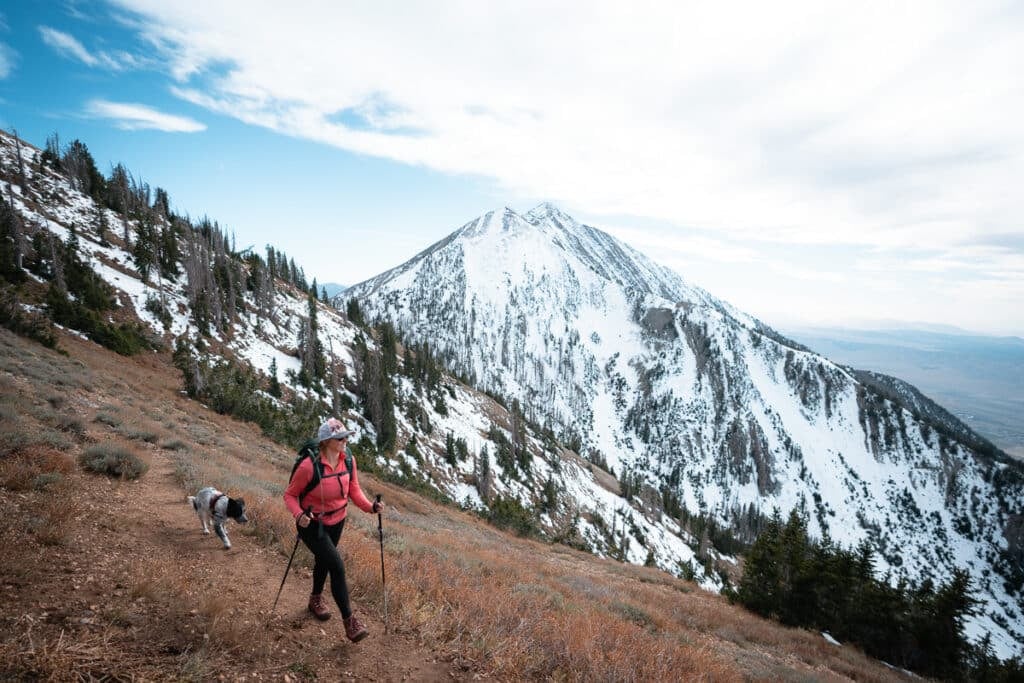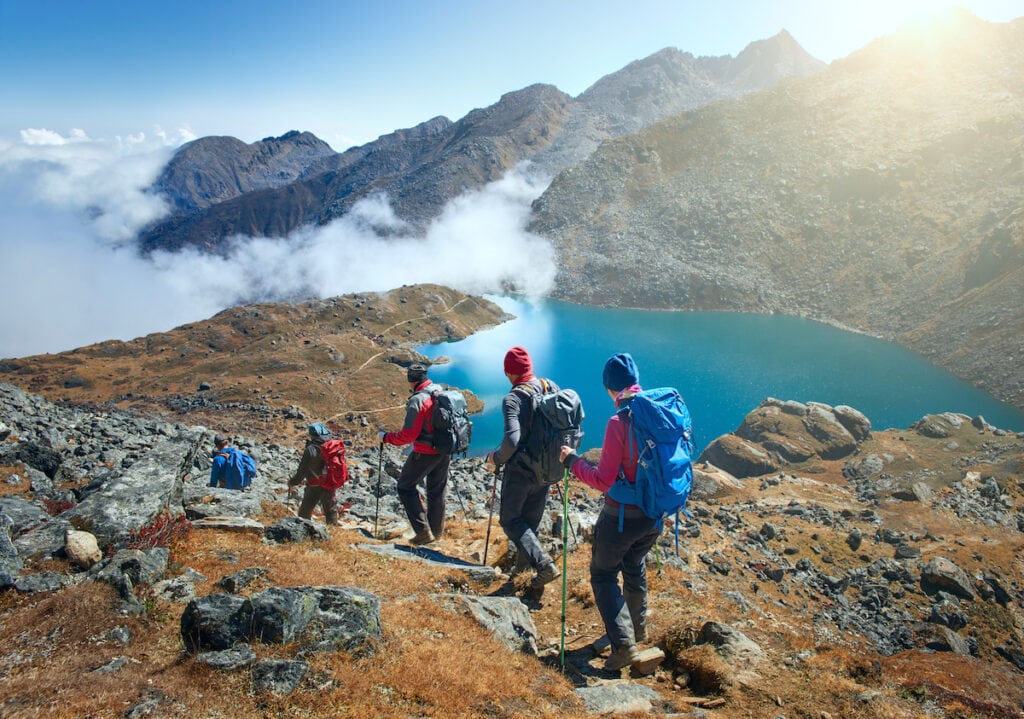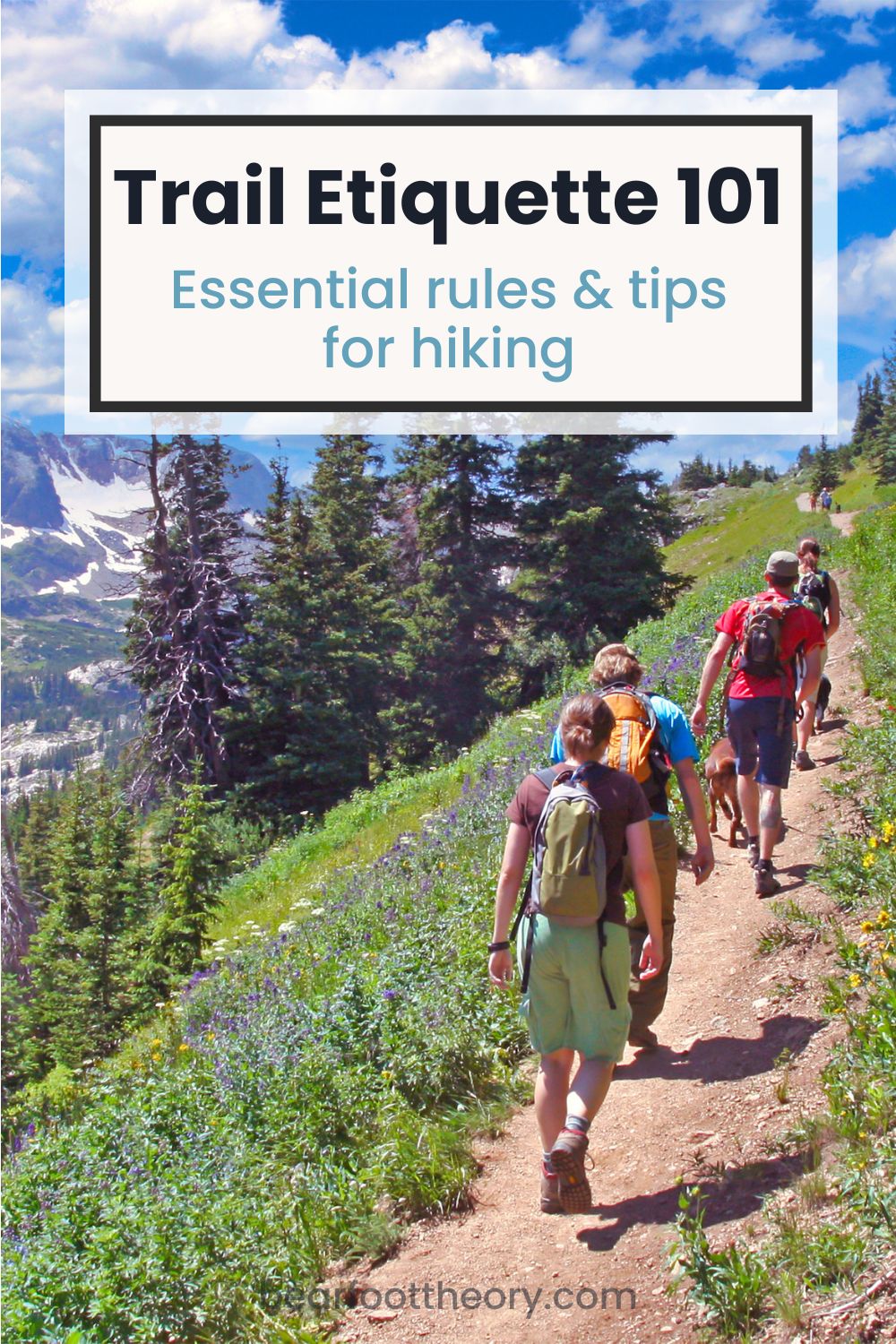Trail Etiquette 101: The Basic Rules of Hiking
Explore the unwritten rules of the trails. Dive into trail etiquette to hike responsibly, coexist with others, and preserve nature’s beauty.

Being aware of proper trail etiquette can make or break your or someone else’s experience outdoors.
If you have ever found yourself held up in a traffic jam on a ridge line or wondered what is the best way to engage with another passerby on a hike, you’re certainly not alone.
More often than not, hiking etiquette is synonymous with common courtesy, but this isn’t always common sense among the masses.
With more people getting outside, knowing the ins and outs of what good trail etiquette looks like is super important for maintaining a positive atmosphere on the trail.
In this post, we share everything you need to know about how to be safe and courteous out on the trails.
This post may contain affiliate links.
Do Uphill or Downhill Hikers Have the Right of Way?
Proper trail etiquette requires downhill hikers to always yield to uphill hikers. Why? The reason is simply that hikers trekking uphill have a more narrow field of vision since they are concentrating on the smaller and more immediate areas in front of them.
Plus, uphill hikers are working hard against gravity to have a good pace and momentum to get them up that steep ridge, so it’s courteous to allow them to keep that momentum.
Downhill hikers, on the other hand, have gravity and a broader perspective that allows them to easily see what’s ahead. Therefore, it is common courtesy for them to give uphill hikers the right of way.
If you are an uphill hiker trying to pass another fellow uphill hiker, it’s nice not to sneak up on them. Instead, wait until the trail is wide enough, and let them know you’re there by simply saying “Excuse me, mind if I pass?”

Read next: How to Protect Your Knees While Hiking
Save this post!
Enter your email & I'll send this post to your inbox! You'll also receive my weekly newsletter full of helpful advice for planning your adventures.
Should Solo Hikers Move for Big Groups?
The answer is yes, solo hikers should move for big groups. This is especially true if the big group is following proper trail etiquette and hiking in a single file so as to not go off trail and risk trampling wildlife.
As a solo hiker or a small group, it’s easier to step aside and let the group pass. Just remember, the passing lanes on a trail are the same as when you drive a car: keep to the right and pass on the left.

What is the Trail Hierarchy Between Horses, Hikers, and Mountain Bikers?
While hikers are used to sharing the trail with other hikers it’s also common to encounter someone on horseback or two wheels.
Whether you are on two feet, four feet, or two wheels everybody has a right to be out there. What’s most important is knowing who has the right of way in order to keep the trail safe.
Mountain Bikers vs Hikers
If you are on a shared trail, be aware that mountain bikers are technically supposed to yield to hikers.
With that said, this is where common sense should come into play. It’s harder for bikers to slow down, so hikers should always be on alert.
In these types of situations, if it’s easier for you as a hiker to step aside, why not help the biker out, so they don’t lose momentum especially if they are going uphill.
Horses vs Hikers
In this case, trail etiquette is the opposite. A rider on horseback will most definitely be moving slower and since horses can be spooked or easily lose their footing on a trail with a loose and granular surface, hikers should safely move out of their way.

What is Trail Etiquette for Dogs?
Even your pooch isn’t exempt from the rules of the trail! Always hike on dog-friendly trails and keep your furry friend on a leash if there are signs that only permit leashed dogs.
If dogs are allowed off-leash, always keep your dog under control and within a line of sight. When another hiker approaches — dog or dog-less— make sure your dog is under your command (either by leash or voice) and step to the side. Be polite and let them know if your dog is friendly or not.
As a part of the Leave No Trace principles, always clean up after your dogs and PLEASE don’t leave your poop bags lying around for others to pick up (even if you intend to pick it up on the way out). That is the definition of poor trail etiquette.
Also, be sure to keep them on the trail and do not let them bother the wildlife or trample on flora and fauna,
Read next: Tips for Backpacking with Your Dog

Be Friendly to Other Hikers
It’s important to be friendly and chatty with other passersby you meet on the trail and not just because you’re all having such a great time.
The benefit of briefly pausing to say hello and chatting about your plans is for safety reasons. Especially if you are on a long day hike, an overnighter or hiking solo, you can learn important info about current trail conditions (or they might fill you in on the best place to camp).
This could also be the difference between having someone know where you are in case of an emergency or having no one to help direct rescuers at all.
Should You Bring Your Smartphone on the Trail?
In the high-tech world we live in today, avoiding smartphones is nearly impossible. So what’s the consensus on bringing your technology out on the trail? Use it sparingly and discreetly and be aware of your surroundings.
Don’t blast music on your phone, make loud phone calls, or get in the way of others while taking a photo.
If you want to play music, we suggest a single earbud, so you can still hear people on the trail or simply turn down the speaker volume when you see others coming.
The bottom line is that using a smartphone on the trail is a personal choice, but be aware of how using it may affect others.
Going to the Bathroom
Everybody has to pee or poop once in a while when you’re out hiking. If that’s you, set your pack off to the side of the trail so it doesn’t block the path, or take it with you so critters don’t get into your food.
Then, according to Leave No Trace, the best practice is to go 200 feet away from any trail, campsite, or water source and do your business.
If 200 feet from the trail isn’t possible without trampling sensitive vegetation or falling off of a cliff, then use your common sense. Do your best to find a private spot behind a rock or a tree so passing hikers aren’t caught off guard.
And please please please, pack out any used toilet paper. There’s nothing more gross than finding used toilet paper on the trail. Bring a small plastic bag to pack it out.
Leave No Trace
An important part of good hiking etiquette includes the guiding principles of Leave No Trace.
In the outdoors, it’s just as important to consider your etiquette toward people as it is to the wildlife and the environment around you.
This frame of mind helps all of us take better care of our wild places and recreate with respect and responsibility by being accountable for our actions.
Here are two great ways to Leave No Trace while hiking; staying on the trail & packing out your trash & waste.
Pack out any trash you find
Always carry in and carry out your trash, recyclables, and food waste and make sure you are following Leave No Trace principles when it comes to human waste.
But carrying out trash shouldn’t just be limited to your own. If you find other trash on the trail that others left behind, pack that out too.
Leave it better than you found it!
Stay on the Trail
While hiking, be mindful and stay on the trail to avoid damaging the surrounding environment and leave the area just as you found it — including rock cairns.
Don’t add or take away from those strategically placed piles of rocks, instead, simply leave them be.
These rock cairns have a navigational purpose and by building your own you could cause someone else to get lost.

READ NEXT
Looking for more hiking tips and outdoor 101 advice? Check out these related blog posts:
What questions do you have about trail etiquette? Is there something we missed? Leave a comment below!


Thanks for the article, especially clarifying who yields. Wish people would mute their damn phones!
One thing needs correction: “Whether you are on two feet or two wheels everybody has a right to be out there.” Mountain bikes are like dogs or horses. They aren’t allowed everywhere. It’s not cool to selectively choose rules we’ll follow then toss out the rest. It makes all of us look bad when other mountain bikers are on hiker-only trails.
Great post, especially about staying on the trail and leaving no trail. Always frustrates me when you see signs asking people to stay on the trail and people completely ignoring them.
Is it okay for hikers to break off branches from trees and shrubs along the trail to use as bug whisks on heavily traveled trails.
Hey Peter! Great question, we recommend searching for something that’s already dead and fallen on the ground. It’s also my personal tactic at warding off mosquitoes during buggy NE summers!
No. Absolutely not.
Uphill hikers should yield! It is dangerous for a downhill hiker to put the “brakes” on, especially when the natural gravity push is exacerbated by a pack. Sudden downhill braking invites twisted ankles, knees, or worse. Uphill hikers do have a more limited vision, but can safely stop and/or step to the side. Just communicate.
Rick (MD)
what is proper etiquette of a dozen in a hiking group who engage in CONSTANT chatter ??
In selection of a hike, is the grade a giveaway as to the strenuousness? IE 450EG vs 850EG?
Do you have a gage for time completion of 4-1/2 miles and 850 EG of rolling hills?
thanks
Elevation gain doesn’t necessarily determine the strenuousness of a hike, but it can give you a general idea of how easy or challenging it will be when compared to mileage. A short hike with a high elevation gain will be more challenging than a long hike with the same elevation gain.
All the normal trail rules can be summed up in simply being a good practitioner of ‘situational awareness.’ Be mindful you’re not the only one using the trail. Don’t be a jerk.
Additionally, an often overlooked (and violated) piece of trail etiquette is to not crowd another backpacker’s tent site. Whoever arrives at that fantastic spot first wins the right to a bit of privacy so they can enjoy that site. That’s not the time to think, “We can squeeze our tent(s) in here, too.” On the trail there are usually many places to pitch a tent. Keep moving until you’ve located another site with enough distance between yourself and others. And for crying out loud, once at your site don’t talk at a 125db. Sound travels far in the wilderness. No one wants a wilderness night intermingled with your loud talking or laughing echoing in the distance. Which circles right back to developing a sense of situational awareness.
All valid points. Thanks for sharing, Bruce!
Great ethics! I wish State parks and national parks required people to learn this and demonstrate it. I have noticed lately, as much as I love kids and think it’s fantastic that families are outdoors, I encounter parents that let the kids scream the whole time they are out. I get it! Nature invokes such delight, but it is disrespectful to the whole experience for others and prob freaks out the fauna! Outdoor etiquette should be instilled in kids too.
Hi Delia, thanks for reading! I love the Junior Ranger program that many NPS sites have for kids. It’s definitely a balance!
Part of the etiquette must surely be; which side of the trail to walk on when there are hikers walking in the opposite direction. I suspect that there is different etiquette for different countries. Can you please explain?
Hi Ken, that’s correct. In our experience, hiking etiquette follows driving rules – if you’re in a country that drives on the left side of the road, you’ll typically find people hiking on the left side of trails. There’s not a blanket correct answer, however, so a good rule of thumb is to follow what the locals are doing and what side of the trail they’re hiking on.
We have a large group of hikers. Recently, 3 slower hikers stopped to drink water and didn’t alert anyone. They got separated from the group and blamed us. Who is responsible for slow walkers in the back of the pack? We realize we should look out for each but shouldn’t everyone know where they are and how to read a trail map, at the very least?? Know how to share their location,?
We have a large group of hikers. Recently, 3 slower hikers stopped to drink water and didn’t alert anyone. They got separated from the group and blamed us. Who is responsible for slow walkers in the back of the pack? We realize we should look out for each but shouldn’t everyone know where they are and how to read a trail map, at the very least?? Know how to share their location??
Hi Kendall – without being there, it’s hard to say. The group in the back should have said, hey were are stopping to drink some water. At the same time, the group in the front should have noticed that they hadn’t seen their friends for a while and said “maybe we should stop and wait.” I think the lesson here is communication is key.
your assertion that uphill hikers should carry their momentum is absurd. If i’m coming downhill i have an added momentum that makes stopping more dififcult. it’s easier for an uphill hiker to pull off because the have less momentum.The downhill traveler is generally going faster, overall efficiency would improve by stopping the slower pedestrian. (total wait time would be less) i always pull over for people coming down.
Hi Mark – This is directly from the National Park Service website: “Hikers coming uphill have the right of way. If you’re descending the trail, step aside and give space to the people climbing up.” Hikers on the uphill are working harder. If the uphill hiker wants to pull over they can, but the rule of thumb is to let the person working harder keep going.